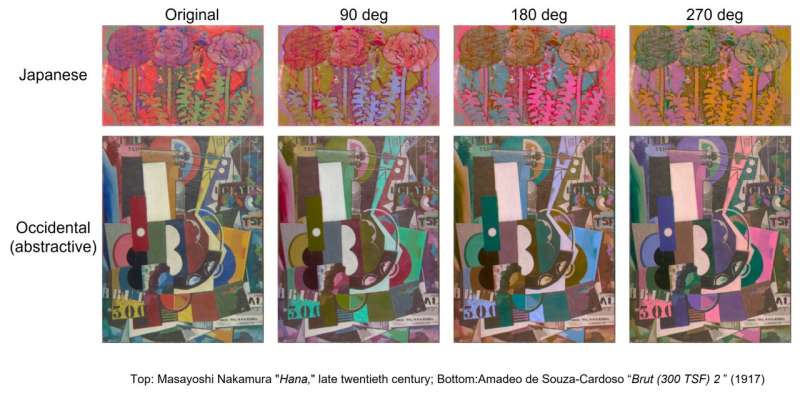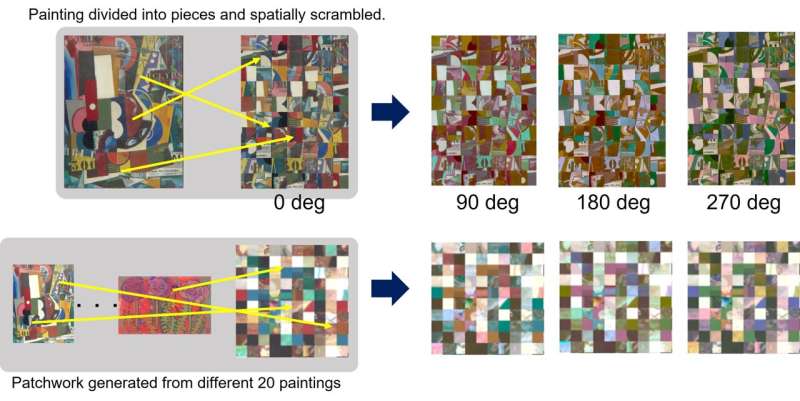Universality observed in preference for color composition in paintings

Professor Shigeki Nakauchi's research team at Toyohashi University of Technology worked with researchers from the University of Minho (Braga, Portugal) to examine preferences for color composition by Japanese and Portuguese people for Japanese and Occidental paintings through experiments using the original paintings and paintings with artificially altered color compositions. It was discovered that regardless of nationality, differences in Japanese and Occidental paintings, and differences in figurative and abstract paintings, many people preferred the original color composition even for paintings they had never seen. This trend can also be seen for the images composed of square pieces collected from different art paintings and composed as patchwork images. The universality in preference for color composition in paintings found in this study suggests that beauty as felt towards paintings may have a common biological basis, more than cultural background or educational experience.
Details
Color is one of the visual elements that has the most influence on personal preference. For example, it has a major influence on a person's decision-making process when selecting clothing or imagining a company's character from the company's logo. Product designers understand well the effect color has on consumer behavior and they utilize this effect as much as possible. There are even professional organizations that predict color trends.
The same is true for the importance of color with paintings. Artists attempt to express their personal esthetic experience unless there is a commercial reason to do otherwise. As a result, it can be said that the color composition of paintings simply reflects the artist's sensibilities and preferences for color. Ample research has been conducted on color preference, but the differences in preference among individuals is great and most of the research have really been conducted for single colors. For this reason, a scientific understanding on preferences for balance or harmony of many colors (color composition) as in paintings hasn't progressed.
To clarify preferences for color composition in paintings, this research altered only the colors in paintings, without altering spatial composition or lightness. The color gamut for each painting piece was rotated counterclockwise around the average color. In doing so, the relationship between colors found in the painting and the average saturation remained unchanged from the original, while the impression of the color composition in the paintings was greatly altered.
We prepared paintings by rotating the color gamut by 90, 180, and 270 degrees counterclockwise, and asked participants in the experiment to pick which color composition they preferred the most from among the four varieties of paintings, which also included the original painting (four-alternative forced choice). For the experiment, 40 paintings were prepared, of which 20 were Occidental and Japanese paintings that were photographed in Portugal and Japan (Toyohashi City Museum of Art and History) and the remaining 20 were taken from art galleries on the internet. 90 people from Japan and 45 people from Portugal participated in the experiment. Participants had not received any special education in art.
From the results of the experiment, we discovered that around 70% of participants, both Japanese and Portuguese, preferred the color composition of the original painting the most, even for paintings that they had never seen before. (However, when selected randomly, this dropped to 25% as chance level.) This trend was the same for abstract painting depicted without objects associated with a specific color, for example the sky or human faces.

We also divided each painting into pieces and scrambled those pieces around, as well as creating a patchwork image from pieces of 20 different paintings to make the content painted in the painting hard to distinguish, as shown in, and carried out the same experiment. We discovered that about 60% of participants favored the scrambled painting of the original painting or the color composition of the patchwork painting of original paintings the most.
These results indicate the following:
- Painters and non-painters share to a certain degree a common standard for beauty and color appeal, regardless of differences in art education or cultural background based on the fact that the color composition selected based on participants' preference coincided as a result with what the painter had painted.
- As the original painting was preferred even when scrambled, there may be some regularities in the color composition that indicates the originality of the painting rather than the memory color offering clues, such as something being painted that evokes a particular image.
- As the original color composition was preferred even for the patchwork images, there may be a biological mechanism to sense beauty (allure) where common characteristics are present among paintings by completely different artists, and both painter and not painter alike sense this beauty whether they are aware or not.
Future Outlook
The research team believes that each person has a mechanism for sensing an allure and beauty for color composition and that this characteristic may be surprisingly common among people. What factors influence beauty? Why do humans have a mechanism to sense beauty in the first place? We hope to answer these questions about beauty, which is considered to be an extremely individual and subjective thing, by clarifying the mechanism behind our decision-making process for "liking" photos on social media, selecting clothing, and deciding on interior decoration for rooms.
The research was published in Scientific Reports.
More information: Shigeki Nakauchi et al, Universality and superiority in preference for chromatic composition of art paintings, Scientific Reports (2022). DOI: 10.1038/s41598-022-08365-z
Journal information: Scientific Reports
Provided by Toyohashi University of Technology



















